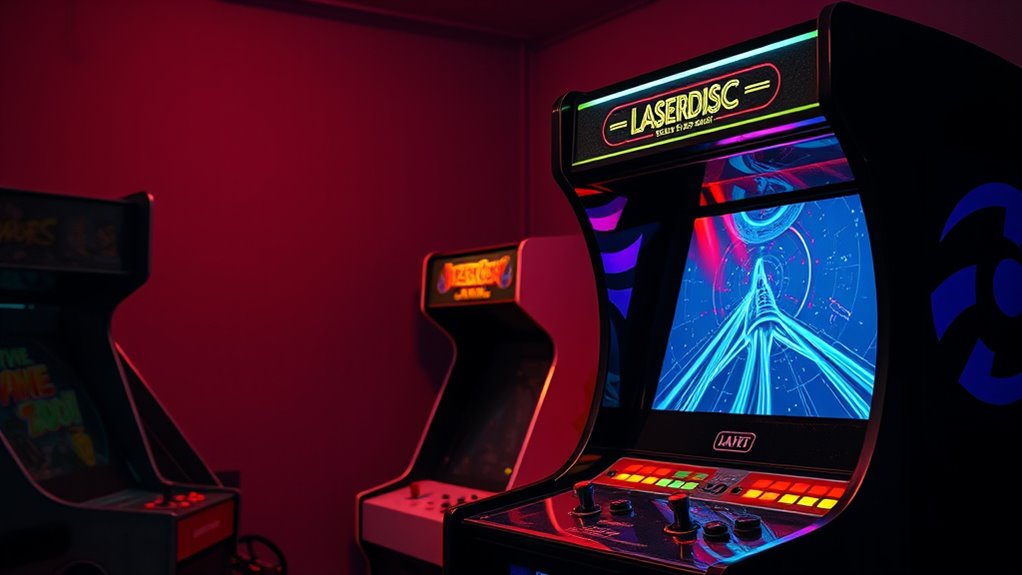Laserdisc arcade cabinets revolutionized gaming by bringing cinematic visuals, branching narratives, and multimedia interactivity to arcades. You experienced high-quality full-motion videos and immersive storytelling that set new standards. However, their bulky hardware, high maintenance costs, and content obsolescence led to market decline. Despite their fall, their influence remains in modern graphics and storytelling techniques. To discover how these pioneering machines shaped gaming history and what legacy they leave behind, explore further.
Key Takeaways
- Laserdisc arcade cabinets pioneered immersive multimedia storytelling and cinematic gameplay, setting industry standards for audiovisual quality and player engagement.
- Their advanced full-motion video technology enabled complex narratives and multiplayer experiences, influencing future game design.
- Hardware limitations, high maintenance costs, and content obsolescence led to declining popularity and eventual decline.
- Competition from CD-based systems and PCs further marginalized laserdisc cabinets in arcades.
- Today, their legacy endures through preservation efforts, emulation, and recognition of their foundational role in multimedia gaming innovation.
The Beginnings of Laserdisc Technology in Arcades
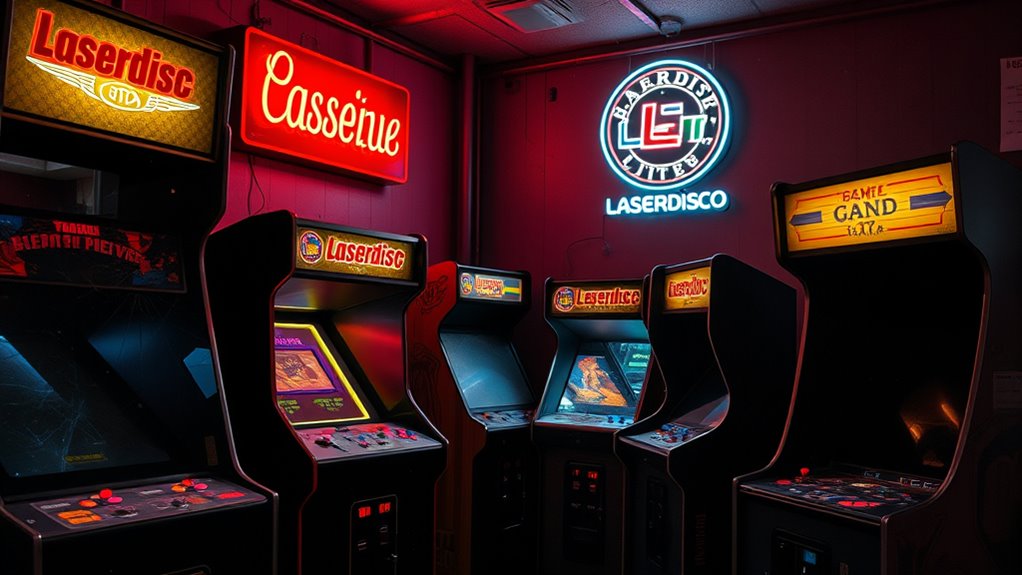
The introduction of laserdisc technology in arcades marked a significant shift in how games were displayed and experienced. It enabled more immersive, interactive storytelling by integrating high-quality video footage directly into gameplay. This innovation transformed arcade cabinets into visual spectacles, spellbinding players with vibrant visuals and seamless multimedia. Unlike earlier arcade systems, laserdisc allowed for complex animations and cinematic scenes that enhanced storytelling depth. You could now engage with games that felt more like watching a movie combined with interactive elements. This leap forward attracted players seeking richer entertainment, pushing arcade design into a new era. The early adoption of laserdisc technology set the stage for future innovations, combining visuals and interactivity to create a truly immersive arcade experience.
Popular Titles and Iconic Games of the Era
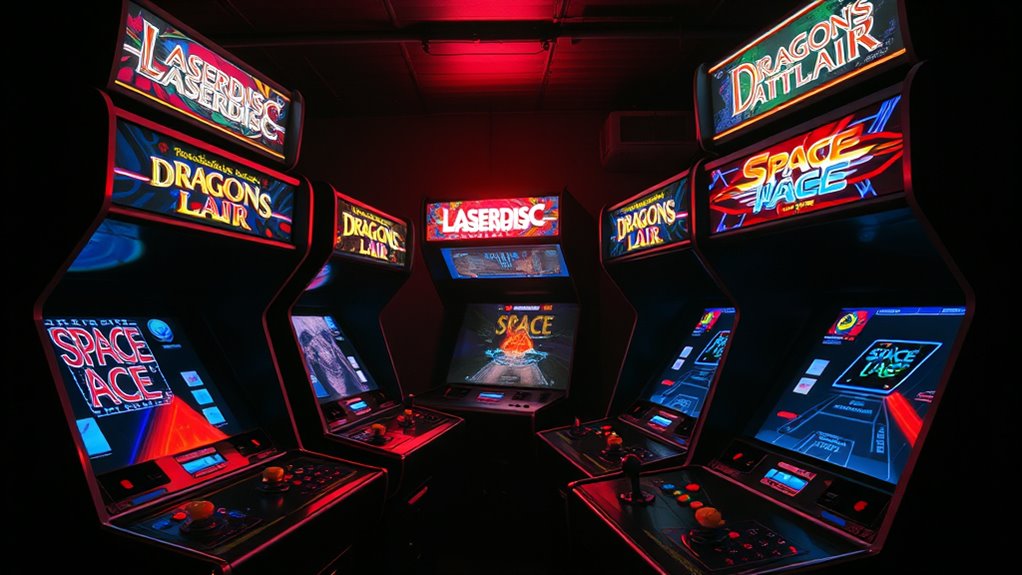
Laserdisc arcade games enthralled players with their groundbreaking use of cinematic visuals and interactive storytelling, making them some of the most memorable titles of the era. Games like *Dragon’s Lair* and *Space Ace* drew you in with their fluid animation and branching narratives, offering an immersive experience unlike traditional arcade titles. These games often featured multiplayer dynamics, allowing players to compete or cooperate in choosing story paths or making quick decisions, heightening engagement. *Mad Dog McCree* combined live-action footage with shooting mechanics, creating a unique interactive experience rooted in storytelling. These titles set a standard for cinematic quality and player immersion, making them icons of their time. Their popularity stemmed from their ability to blend storytelling with gameplay, enthralling audiences and elevating arcade entertainment. Additionally, the technology behind laserdisc revolutionized how visual narratives could be integrated into interactive entertainment, influencing future multimedia experiences.
Technological Innovations and Gameplay Experience
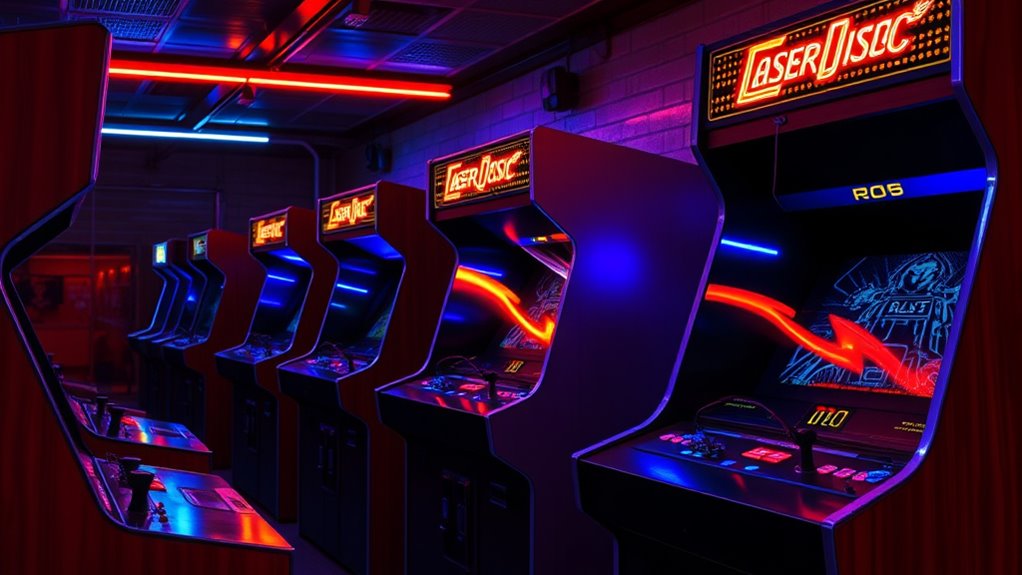
Advancements in laserdisc technology revolutionized arcade gaming by delivering unprecedented visual fidelity and interactive capabilities. You could experience immersive storytelling through full-motion video, making gameplay more engaging and cinematic. These innovations allowed for complex narratives and branching storylines, elevating the player’s immersion. Multiplayer dynamics also improved, as players could compete or cooperate in shared experiences, often involving simultaneous inputs and interactive decision-making. Laserdisc cabinets offered a level of realism and depth previously unseen in arcade games, drawing players into vibrant worlds with rich visuals and sound. These technological leaps not only enhanced gameplay but also set new standards for cinematic quality in arcade entertainment. Additionally, the visual presentation of laserdisc games was influenced by advances in display technology, further enriching the player’s experience. Overall, laserdisc technology transformed the gaming experience, making it more interactive, social, and visually impressive.
Challenges and Limitations of Laserdisc Cabinets
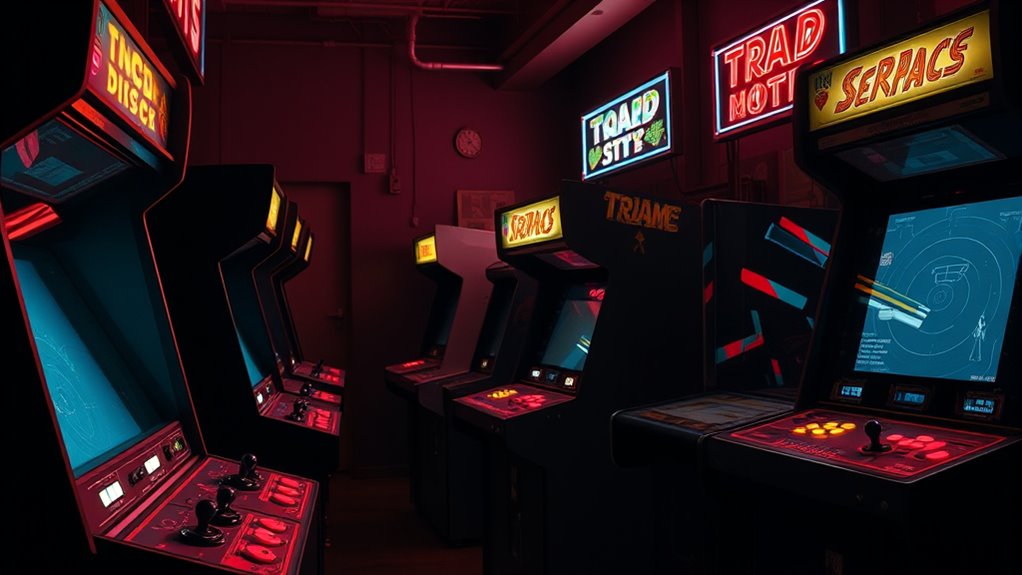
Despite their impressive visuals and immersive capabilities, laserdisc arcade cabinets faced significant challenges that limited their widespread adoption. One major issue was hardware limitations; the technology required bulky, fragile components that often failed or degraded over time. This made maintenance costly and complicated, leading to frequent downtime. Additionally, content obsolescence was a persistent problem. As new games emerged, older laserdisc titles quickly became outdated because updating content meant replacing entire discs or hardware, which was expensive and impractical. The large size of the laserdisc players also restricted cabinet design flexibility and increased costs. These limitations hindered scalability and made arcade operators hesitant to invest heavily in laserdisc technology, ultimately contributing to their decline despite their initial appeal. Furthermore, the content update process was cumbersome, often requiring costly hardware upgrades that discouraged operators from maintaining the system long-term.
Factors Leading to the Decline of Laserdisc Gaming
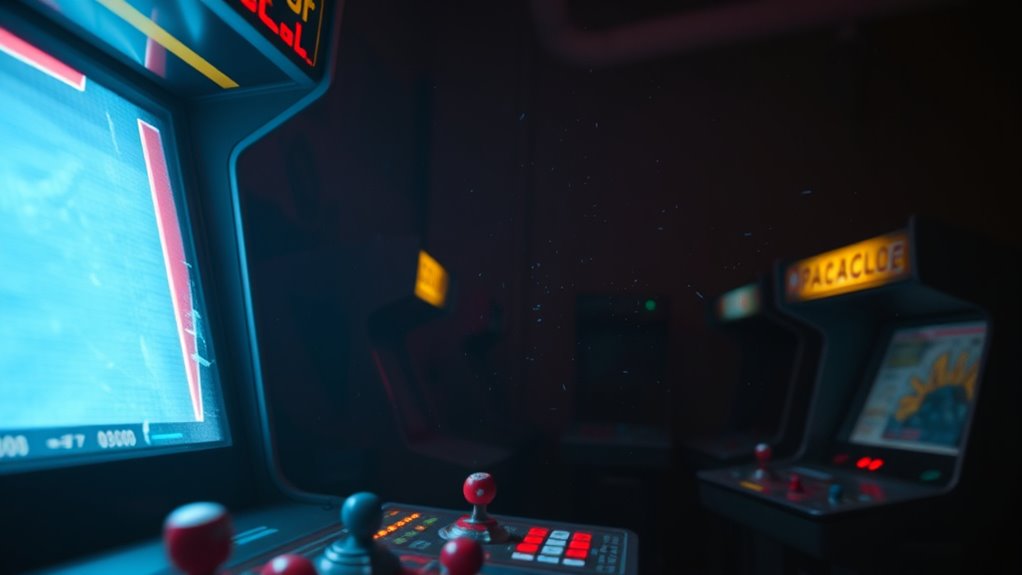
The decline of laserdisc gaming was driven by a combination of technological shortcomings and market factors that ultimately made the format less viable. The intense market competition from newer technologies, like CD-based systems and PC gaming, overshadowed laserdisc cabinets. Additionally, maintenance challenges became a significant issue, as laserdiscs and projectors required frequent repairs, increasing costs and downtime. This made arcade operators hesitant to invest in or sustain laserdisc setups. The table below highlights key factors:
| Factor | Impact |
|---|---|
| Market competition | Reduced consumer interest and arcade foot traffic |
| Maintenance challenges | Increased operational costs and technical failures |
| Technological gaps | Outdated hardware compared to emerging formats |
These issues combined to accelerate the format’s decline, pushing laserdisc gaming out of the mainstream.
Legacy and Influence on Modern Gaming
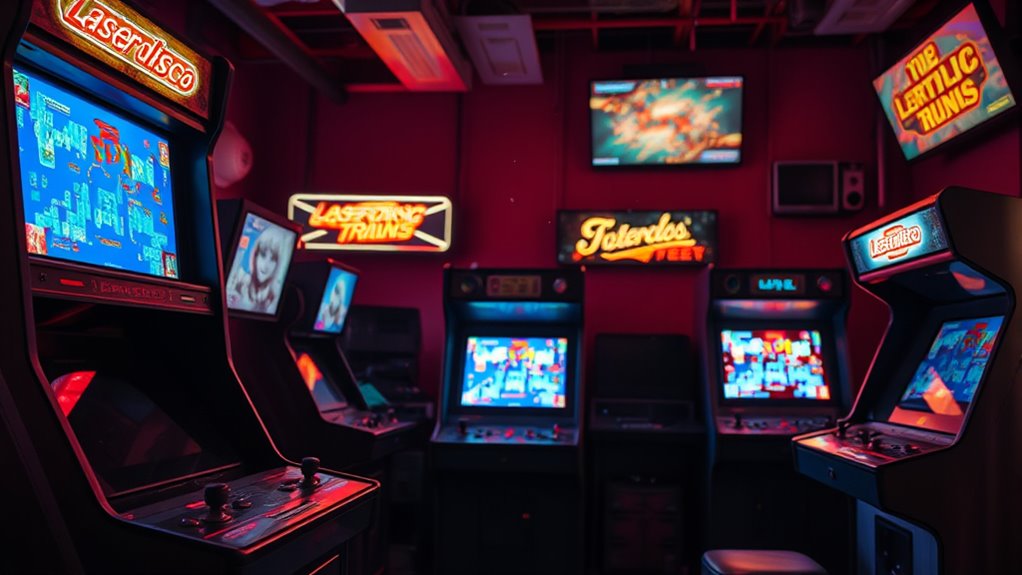
Laserdisc arcade cabinets pushed technical boundaries that still inspire today’s gaming innovations. You can see their nostalgic cultural impact in how they shaped early entertainment experiences. Their influence also extends to modern technology, affecting how we interact with digital media and immersive gameplay. Additionally, retail hours for related gaming stores have evolved, reflecting the ongoing popularity and adaptation of arcade gaming experiences.
Technical Innovations Inspiration
Although laserdisc arcade cabinets eventually faded from popularity, their technical innovations have left a lasting mark on modern gaming. They pioneered interactive storytelling by integrating full-motion video and branching narratives, inspiring later multimedia and narrative-driven games. The technology demonstrated the potential for immersive experiences beyond traditional gameplay, encouraging developers to explore new storytelling methods. Additionally, the focus on hardware durability in laserdisc cabinets set a standard for arcade machines, ensuring they could withstand heavy use in public spaces. This emphasis on reliability influenced the design of future gaming hardware, emphasizing robustness and longevity. Moreover, the emphasis on hardware durability inspired the development of more resilient gaming consoles and arcade systems, ensuring longevity and reduced maintenance costs. Overall, the innovations in interactive storytelling and durable hardware from laserdisc cabinets continue to inspire modern game development and arcade design, shaping the evolution of immersive and resilient gaming experiences.
Nostalgic Cultural Impact
Despite fading from arcades, laserdisc cabinets left a lasting cultural legacy that continues to influence modern gaming. They sparked arcade nostalgia, reminding players of innovative visuals and immersive experiences. Their cultural significance goes beyond gameplay, shaping how we view interactive entertainment’s potential. Today’s game designers draw inspiration from the pioneering spirit of laserdisc technology, blending cinematic quality with gameplay. The integration of full-motion video in early arcade titles demonstrated the potential for multimedia storytelling in gaming.
Influences on Modern Tech
The innovations introduced by laserdisc arcade cabinets have profoundly shaped modern gaming technology. They pioneered interactive storytelling, allowing players to influence narratives through choices, a concept now central to many video games. These cabinets also advanced multiplayer dynamics, enabling players to compete or cooperate in shared experiences, laying groundwork for today’s online multiplayer platforms. The use of high-quality video and audio set standards for immersive gameplay, inspiring developers to incorporate cinematic elements into their designs. Additionally, laserdisc technology informed the development of more sophisticated hardware, pushing the industry toward more complex and engaging game experiences. The standardization of multimedia elements established by laserdisc technology helped foster a more immersive and cinematic approach to game design, influencing the evolution of the industry. As a result, the legacy of laserdisc arcade cabinets endures, influencing modern gaming’s emphasis on narrative depth and social interaction.
Preserving the Nostalgia: Collecting and Emulation
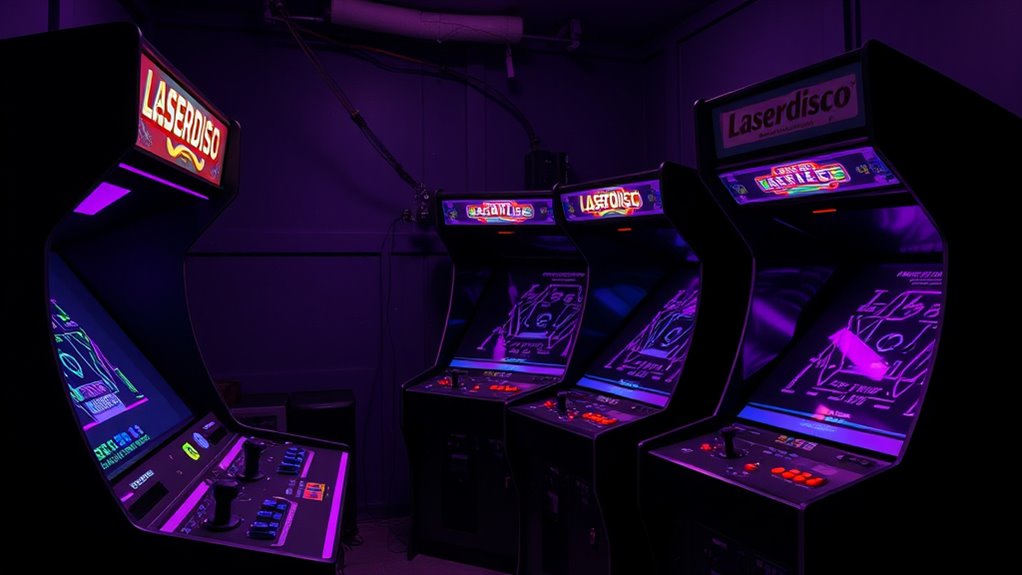
Preserving the nostalgia of laserdisc arcade cabinets involves both collecting physical artifacts and embracing modern emulation techniques. You become part of a dedicated community that values digital preservation to keep these games alive. Collectors seek out rare laserdiscs, authentic cabinets, and original hardware, often sharing resources and tips within collector communities. Emulation offers a practical way to experience these classics when originals are unavailable or fragile. Visualize:
- Restored arcade cabinets glowing under dim lights
- Carefully preserved laserdiscs stored in protective cases
- Digital archives accessible on modern devices
- Enthusiasts exchanging rare finds at conventions
- Emulators running on sleek computers with authentic graphics
Additionally, understanding the copyright implications of digital preservation ensures that these efforts respect legal boundaries and protect creators’ rights.
Frequently Asked Questions
How Did Laserdisc Technology Compare to Other Arcade Display Systems?
You’ll find that laserdisc technology offered better visual quality than many early arcade display systems, with sharper images and full-motion video capabilities. However, it also faced significant technological limitations, such as slower response times and susceptibility to playback issues. Compared to other systems like CRTs or early LCDs, laserdiscs provided impressive visuals but couldn’t fully overcome these constraints, which eventually affected their popularity in arcade settings.
Were There Any Notable Regional Differences in Laserdisc Arcade Popularity?
You might think laserdisc arcades were a global hit, but regional preferences and cultural influences told a different story. In Japan, they thrived, blending tech with anime culture, while North America stuck with classic pinball. Meanwhile, Europe was too busy debating whether laserdiscs were futuristic or just fancy VHS. So, yes, regional differences shaped laserdisc popularity, proving that where you are can determine whether you get pixelated paradise or just plain old arcade nostalgia.
What Were the Cost Differences Between Laserdisc and Traditional Arcade Cabinets?
You notice that laserdisc arcade cabinets had higher initial costs compared to traditional ones. A thorough cost analysis shows they were more expensive to purchase, mainly due to advanced technology. Additionally, maintenance expenses for laserdisc systems were higher because of fragile discs and complex hardware, unlike traditional cabinets that were cheaper and easier to maintain. Overall, the cost difference made laserdisc cabinets less attractive for operators seeking budget-friendly options.
Did Laserdisc Arcades Influence Home Entertainment Systems?
You might notice that laserdisc arcades influenced home entertainment systems by showcasing high-quality laserdisc quality visuals and sound. This technology brought a new level of immersion, sparking arcade nostalgia and inspiring innovations in home media. As a result, many gamers and tech enthusiasts began seeking similar experiences at home, leading to improvements in home theaters and the adoption of laserdisc players, blending arcade excitement with personal entertainment.
Are Any Laserdisc Arcade Cabinets Still Operational Today?
Like a rare gem hidden in a dusty attic, some laserdisc arcade cabinets still shine today. You might find a few in museum collections, preserved as nostalgic relics. However, maintaining these classics is a challenge, given their age and the scarcity of replacement parts. Despite the hurdles, dedicated enthusiasts keep them operational, ensuring that this unique piece of gaming history continues to captivate visitors and collectors alike.
Conclusion
You can see how laserdisc arcade cabinets revolutionized gaming with their immersive visuals, reaching peak popularity in the late 1980s. notably, at their height, over 10,000 units were sold worldwide, showcasing their impact. Despite challenges like high costs and technical issues, their influence lives on in modern multimedia experiences. Preserving these classics through collections and emulation keeps the nostalgia alive, reminding us of a bold era when arcade gaming truly pushed technological boundaries.
